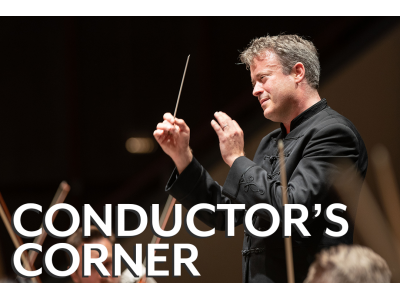Conductor's Corner: Orchestra Setup

Why do we set up the orchestra the way that we do?
One of the most frequent questions I get after a performance is, “Why did you set up the orchestra the way you did”? Many concertgoers notice when we change the relative position of instruments (or groups of instruments) on stage, and I thought it would be interesting to pull back the curtain to explore this in greater detail.
Large groups of instruments playing together surely existed in the Renaissance. Still, it wasn’t really until the Baroque period that this became more or less common. Even still, there was no consistent standard setup. As we see from woodcuts and paintings of the period, musicians seemed to group themselves together in an ad-hoc way, often standing or sitting around a central keyboard instrument (harpsichord or organ) much as a jazz combo might set up on stage.
The main venues for performing music were the church, where singers and musicians would jostle for space in a crowded organ loft, theatres, or opera houses (as opera became more popular in certain countries), and large ballrooms at the local palace.
Moving ahead to the time of Mozart and Haydn, the instruments making up an orchestra were becoming more or less standardized, as was the configuration of setting them up on stage. Still, there were some great variations: woodwinds were known to stand around the piano for the performance of some of Mozart’s later concerti; Haydn string quartets were often played with the first violin standing and the other three musicians sitting.
The basic configuration by the time we get to Beethoven and the Romantics was to have the two violin groups mirrored across the stage from each other and the rest of the strings in the middle, with woodwinds, brass, and percussion towards the back. In some places (like Vienna), the double basses were placed behind everybody else at the back of the orchestra. It also became important to preserve good sight lines for the newest member of the symphony orchestra: the conductor!
Hector Berlioz, one of the most unconventional and experimental of the romantic composers, even specified a particularly odd and extravagant stage setup for his Romeo & Juliet — including the construction of large risers, a chorus placed in front of the orchestra, and two conductors!
At the beginning of the 20th century, a new configuration of the strings came into use in America — placing both violin groups next to each other, then the violas and cellos on the outside of the stage to the conductor’s right. This configuration has been attributed to Leopold Stokowski, but it was in use (and had found its way to England) before Stokowski began his career as a top conductor. Some would conjecture that the idea of separating the treble instruments from the low instruments coincided with the dawn of the earliest wax recordings when orchestras were often drastically reseated to create a good balance for the sound collector.
Today, many composers specify how they would like their orchestra to be seated — but without any clear direction from the composer, I like to create stage placements that support the music and the musicians, placing those instruments close together who can benefit from hearing each other well. Next time you are at a KSO concert, have a look at where the different musicians are seated!



